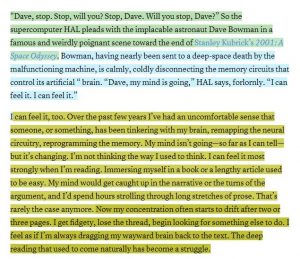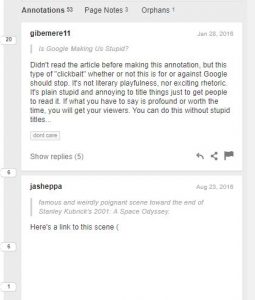Incorporating technology in education should start in elementary school. Children today are growing up with all kinds of new technology, which is very different from when my generation was growing up. We should embrace it and show our young students how to use it effectively for learning. The digital age, such as reading online, is a big part of modern life and incorporating this learning tool within the educational system at an early age will only enhance comprehension skills. Educators can do this by teaching children how to annotate online articles, limit multitasking, avoid distractions, and make reading online more engaging.
The first way teachers can help their students better comprehend texts when they read an e-book is by using the website, Hypothesis. This website is used to bring the traditional form of highlighting and writing in the margins to screens. If we can teach elementary students how to annotate books online then they will be better prepared for the future will be less likely to skim read. When an article is uploaded to Hypothesis, there are tools to highlight, add hyperlinks, and just add personal notes into the article.


According to La Farge, readers that are given a text on a screen do not comprehend what they have read as well as someone who reads the same text on paper. In fact, people are more likely to skim an online article because they have become so used to the Internet being fast and getting information right away. Hypothesis can engage young readers in deep reading and make the note-taking fun. I know using Hypothesis helped me in my English class in college and I wish I had been shown this process sooner in my academic career.
Another way educators can improve their students’ comprehension skills is by limiting multitasking in the classroom. Multitasking has been proven to slow productivity, according to Goldhill. She says, “attempting to do two challenging tasks at once will lead to a drain in productivity.” Let’s say a teacher is conducting an English lesson and a student is reading a book, unrelated to the subject of the class, while the lesson is going on. That student will not remember much from the lesson or be able to completely focus on their book because their attention was divided. If we can train students at a young age not to attempt to do more than one task at a time, it will better prepare them for understanding texts in the future. Educators can set designated times for reading and have all their students adhere to that schedule. It is easier to concentrate on a book when everyone else is being quiet and not getting distracted by other tasks.
Likewise, distractions when students are using the Internet is also a problem when it comes to students’ education. Technology can help with this, even though it is one of the causes of distractions. As Goldhill says, our mornings are spent checking emails, scrolling through Facebook, and Googling questions. These notifications are popping up on our phones or on our computers and before we know it, we have forgotten what we originally had planned to accomplish in the day. Elementary schools are full of distractions with yelling children, colorful images, and even the classroom pet can be disruptive. Elementary school teachers can at least limit interruptions when their students read online by installing software to block advertisements and block messages that mean to draw their attention away from the task at hand. I can agree that it would definitely be worth it to have such programs to block everything that interrupts my online reading experience.
The last way the education system can help students with reading on the Internet is by making online texts more interactive. Children would grasp reading on screens much more effectively if it were hands-on. As Jabr says, some forms of electronic readings are meant to be read on a tablet or computer; they rely on scrolling and clicking. With that said, I don’t see why we can’t use interactive e-books to engage students in the words. It’s not so different from when I was younger and using my low-tech Leapfrog at home to help me better comprehend what I was reading. Elementary schools should get students used to scrolling and tapping on words in e-books so that they will carry that excitement for reading with them throughout their educational career.
Educators for young children have an important role in their students’ lives. It is in elementary school that a child’s love for learning begins. I believe we have a responsibility to show our young students how to use all of this new technology to their advantage. Incorporating more technology in schools and using them as educational tools will help students succeed further down the road.
Works Cited
Carr, Nicholas. “Is Google Making Us Stupid?” The Atlantic, Jul. 2008, https://www.theatlantic.com/magazine/archive/2008/07/is-google-making-us-stupid/306868/ Accessed 11 Oct 2017.
Goldhill, Olivia. “Neuroscientists Say Multitasking Literally Drains the Energy Reserves of Your Brain.” Quartz, 3 Jul, 2016, https://qz.com/722661/neuroscientists-say-multitasking-literally-drains-the-energy-reserves-of-your-brain/ Accessed 11 Oct. 2017.
Jabr, Ferris. “The Reading Brain in the Digital Age: The Science of Paper versus Screens.” Scientific American, 11 Apr. 2013, https://www.scientificamerican.com/article/reading-paper-screens/ Accessed 11 Oct. 2017.
La Farge, Paul. “The Deep Space of Digital Reading.” Nautilus, 7 Jan. 2016, http://nautil.us/issue/32/space/the-deep-space-of-digital-reading. Accessed 11 Oct 2017.